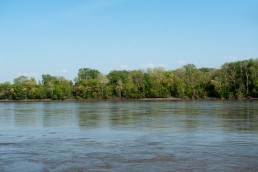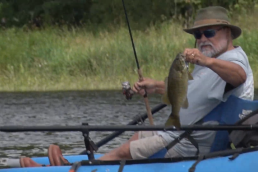Lower Fox River: Spring Water Temperatures Matters
SHARE THIS POST
Spring fever! Time to move from the augers and short rods of ice fishing, to the long rods of open water fishing. For walleye fishermen, spring provides one of the best opportunities to chase personal bests, record walleyes or just plain adrenaline rushes.
One of the most prestigious spring walleye fishing “hot spots” of the upper Midwest every is the lower Fox River in northeastern Wisconsin. The lower Fox River is unique, as it is one of the few major rivers in the United States which flows from south to north. The mouth of the Fox River dumps into the southernmost part of the Bay of Green Bay.
Water temps below 40 degrees
Each spring, thousands of adult walleyes move into a seven-mile stretch from the mouth of the Fox River in Green Bay, WI to the dam in De Pere, WI. Traditionally, numerous males begin filtering into the river in October and will reside in the river all winter (assuming food is available) in anticipation of the spring spawning run. By St. Patrick’s Day, the river is full of eager male walleyes ranging in size from 12 to 24 inches plus.
While water temperatures remain under 40 degrees, many of the walleyes associate with several key structures on the Fox River in De Pere. With the shorelines still locked in ice and the fish locked in winter patterns, presentations need to be slow and methodical.
During this period, the males are incredibly predictable in their locations. Generally, these fish remain in the center river channels, residing most days in the bottom quarter of the water column. While the walleyes are feeding, most are unwilling to aggressively chase baits in the cold water. Opportunistic feeding walleyes also reside along current breaks.
Popular tactics revolve around jigs and live bait. On the Fox River, daily/hourly changes occur regarding preferences toward either shiners or fathead/tuffy minnows. Shiners provide more flash, while fatheads tend to be a little hardier and last longer on the hook (and are generally less expensive, too). Stinger hooks should be used to increase catch rates early in the open-water season.
during early season on the Fox River, soft plastics are generally ineffective unless under three inches in length.
Jigging cadence is critical. The jigging stroke should be a lift, two-second pause at the top, and drop motion. Many anglers pause when the jig hits bottom rather than at the top of the stroke. Holding the jig at the top of the lift allows for walleyes to locate the bait and attack the bait when it falls. The bait held in their faces is much more productive than a jig sitting motionless on the bottom.
Standard practice is to not use ‘crawlers until the first heavy rain of the season, or until the nightcrawlers come out of the ground. I have had much success with a quarter-crawler on a jig during this cold-water period. Consider just how many jigs and minnows pass by a walleye this time of year? Having a unique presentation can produce drastically different results.
The De Pere Dam is the most popular place on the river this time of year. Anglers often do very well for pre-spawn females casting stick baits or shad baits into the rapids. This can be done from a boat, the island, or the observation decks near the dam.
Water temps 40-45 degrees
Once water temperatures reach the 40-degree mark, female walleyes arrive in greater numbers and begin to stage throughout the river, especially near the De Pere Dam. Anglers will congregate in the mile-long stretch from the Hwy 172 bridge to the dam. Hundreds of anglers on a single day are not uncommon in this stretch of waterway. With the increased boat traffic, the male walleyes tend to become spooked, and will flush out to the side of the river or retreat to the deepest holes.
While most anglers concentrate on that final mile, many excellent locations in the other six miles of waterway up to the mouth are less popular yet productive attractions. The river has had PCB cleanup efforts ongoing since 2009, and numerous habitat additions have been added to the waterway as a byproduct of the dredging. Be sure to utilize your electronics, as many of the new habitats will not appear on your mapping chips or apps.
Are you enjoying this post?
You can be among the first to get the latest info on where to go, what to use and how to use it!
The Fox River has special Department of Natural Resource (DNR) regulations during this period: one trophy can be kept each day, with a 28-inch minimum. The locals refer to them as “legals.” Check the WI-DNR website for details. It is not uncommon to catch and release multiple “legals” in a single outing on the Fox River in March and April, with an average walleye measuring 22 to 24 inches.
The largest females in the system are often in the rivers for the spawn each year, including a few in excess of 12 pounds. As the water warms to about 45 degrees, vigorous spawning activity will occur at the dam. The average spawn occurs April 10th.
The best methods to attract fish in this temperature range are jigs tipped with soft plastics between three and five inches in length, hair jigs and vibrating baits. Fishing them aggressively creates reaction bites.
Trolling bites start to fire off in the 10-foot depth range or less. Think large and slow in your bait presentations and use size 10 crankbaits to attract giant walleyes. Speed becomes a critical factor this time of year. A tenth of a mile an hour can affect catch rates. Generally, .6 to 1.1 mph is the target speed. Using “S” turns in the trolling pattern will help determine speed preference each day. Bait color is variable and is driven by water clarity and sunlight penetration.
The night troll is a riot. Big fish and reduced boat traffic make for a more enjoyable environment. This is truly the time of day to target a personal best walleye, as the low-light periods have the most active walleyes.
Water temps above 45 degrees
Typically, female walleyes enter the river system, spawn and exit to the Bay of Green Bay within a few days; however, some can remain for weeks in the river system. Their focus changes from spawning to recovery at this time.
Anglers quickly vacate the river after the spawn, with boats moving to other bodies of water, such as the Peshtigo River, Oconto River and the Menomonie River, which have later walleye spawns. In some parts of the state, other river systems have larger bag limits, and some anglers opt for pursuing table fare versus wall hangers.
Post-spawn fish are often located in the warm, sandy backwaters as they recover from the spawn. One of the key elements affecting exit from the river system is the strength of the current. A strong current can make the productive season shorter, with the females riding the current back to the Bay of Green Bay nearly immediately after the spawn; a weaker current can encourage extended residency in the river. The availability of food sources is another contributing factor as to how long the nonresident river walleyes stay.
Try trolling small crankbaits with tight wobbles in the 6-14-foot depth ranges, at an increased speed. Downsizing crankbaits during the recovery period is suggested, as the appetite of the recovering walleyes tends to be less than during the pre-spawn period. If your target is the center channel, try to fish higher in the water column, as the fish will ride high while returning to the lake.
This is also prime time for actively casting into the shallows for monster walleyes. A common mistake during this period is fishing too deep. Many elite walleyes will push up into less than five feet of water, especially if the water is stained. Casting crankbaits and working Rippin’/Jigging Raps are some of the best ways to trigger these walleyes to bite.
Don’t give up on the Fox River too quickly. Shortly after the walleye run, a strong white bass run will follow. The De Pere white bass run can rival the Wolf River (Fremont), and receives almost zero attention. Accidental muskies are always a possibility this time of the year and become more numerous as May approaches. Often, my biggest walleye of the season will be caught during this period, after many anglers have lost interest in the Fox.
Males typically remain in the river for several weeks after the spawn, and eventually become resident fish or eventually make their way out to the bay. Significant opportunities exist after the fishing opener to add some fillets to the freezer, after the bag limit regulation increases on the Fox.
MWO
SHARE THIS POST
Did you enjoy this post?
You can be among the first to get the latest info on where to go, what to use and how to use it!
Mark Strand
MidWest Outdoors editorial director Mark Strand is a graduate of University of Minnesota School of Journalism with a minor in Fisheries & Wildlife Science. He has written for nearly every outdoor magazine over the past 41 years, and has written or co-written 14 books. In addition to writing and photography, Strand produces the MidWest Outdoors Podcast, and contributes to MWO digital properties. He is an outdoor generalist who loves hunting and fishing of all types. In 2018 Strand was elected to the Minnesota Fishing Hall of Fame.



